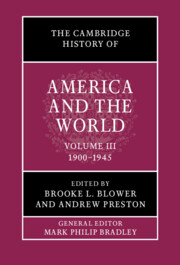Book contents
- The Cambridge History of America and the World
- The Cambridge History of America and the World
- The Cambridge History of America and the World
- Copyright page
- Contents
- Figures
- Maps
- Contributors to Volume III
- General Introduction: What is America and the World?
- Introduction to Volume III
- Part I American Power in the Modern Era
- Part II Competing Perspectives
- Part III The Perils of Interdependence
- 21 Borders and Migrants
- 22 Economic Catastrophes
- 23 Corporate Imperialism and the World of Goods
- 24 The Body Politics of US Imperial Power
- 25 Agriculture and Biodiversity
- 26 Worlds of International Development
- 27 Preserving Peace and Neutrality
- 28 The American Way in World War II
- 29 The Republic of Science and the Atomic Bomb
- 30 Visions of One World
- Index
25 - Agriculture and Biodiversity
from Part III - The Perils of Interdependence
Published online by Cambridge University Press: 12 November 2021
- The Cambridge History of America and the World
- The Cambridge History of America and the World
- The Cambridge History of America and the World
- Copyright page
- Contents
- Figures
- Maps
- Contributors to Volume III
- General Introduction: What is America and the World?
- Introduction to Volume III
- Part I American Power in the Modern Era
- Part II Competing Perspectives
- Part III The Perils of Interdependence
- 21 Borders and Migrants
- 22 Economic Catastrophes
- 23 Corporate Imperialism and the World of Goods
- 24 The Body Politics of US Imperial Power
- 25 Agriculture and Biodiversity
- 26 Worlds of International Development
- 27 Preserving Peace and Neutrality
- 28 The American Way in World War II
- 29 The Republic of Science and the Atomic Bomb
- 30 Visions of One World
- Index
Summary
“This is a record of land: of soil, rather than people,” begins Pare Lorentz’s 1936 documentary, The Plow that Broke the Plains: “a story of the Great Plains, the 400,000,000 acres of wind-swept grass lands that spread up from the Texas panhandle to Canada; a high, treeless continent; without rivers, without streams; a country of high winds, and sun, and of little rain.”1 Ostensibly, the film’s purpose was to boost New Deal efforts to resettle struggling farmers and rehabilitate impoverished soil. Rex Tugwell, as head of the New Deal Resettlement Administration (RSA), sponsored Lorentz’s film on the recommendation of Henry Wallace, who was at that time Franklin Delano Roosevelt’s secretary of agriculture. Yet coverage of these topics was confined to scarcely three minutes of expository text, hastily tacked on to what Lorentz characterized as “a melodrama of nature – the tragedy of turning grass into dust.” In just over twenty-eight minutes of film, Lorentz’s first attempt at movie-making tracks the boom and bust of Midwestern agriculture and the ecological crisis of the Dust Bowl of the 1930s (). Stylistically, the film owed more to silent pictures than talkies. For the score, the popular composer Vergil Thompson wove an epic tapestry of military marches, ragtime, popular spirituals, and folk songs. Finis Dunaway dubbed Lorentz’s film a “secular prayer to the possibilities of New Deal reform,” but Thompson’s score made it otherwise: over a meditative shot of a horse’s skull on cracked earth, an organ slowly pounds out the Lord’s Prayer.2 Thompson’s musical references help us understand how shared crises can be made nationalist ones. They also serve as a reminder that, contrary to Lorentz’s claims to deal in soil rather than people, liberal reforms were social and political projects, and that the hopes pinned to them were not universally held.
- Type
- Chapter
- Information
- The Cambridge History of America and the World , pp. 591 - 616Publisher: Cambridge University PressPrint publication year: 2022

